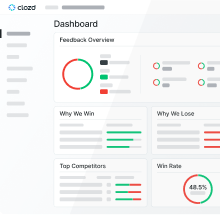As a Chief Revenue Officer, you're constantly under pressure to drive sustainable revenue growth. It's a relentless pursuit, demanding not just a keen eye on the numbers, but a deep understanding of the forces shaping your market. While CRM data offers a snapshot of your sales pipeline, it often leaves critical questions unanswered: Why did we win that deal? Why did we lose that one?
The answers to these questions are gold, and they're precisely what win-loss analysis delivers. It's more than just a post-mortem; it's a strategic imperative that empowers CROs to unlock actionable insights, refine strategies, and ultimately, accelerate revenue growth.
What is Win-Loss Analysis, and Why Does it Matter for CROs?
At its core, win-loss analysis is a systematic process of understanding the reasons behind your sales outcomes. It's about going beyond surface-level assumptions to uncover the true drivers of success and failure in your sales deals. For a CRO, this isn't just an interesting exercise; it's a direct pathway to optimizing your entire revenue engine.
Beyond the Scorecard: The True Purpose of Win-Loss Analysis
Many organizations track win rates, but true win-loss analysis delves much deeper. It's not simply about tallying wins and losses; it's about gathering in-depth, qualitative feedback directly from the prospects and buyers involved in your sales process. This means conducting structured interviews with both won and lost accounts to understand their decision-making journey, their perceptions of your solution, your sales team, your competitors, and your overall value proposition.
The purpose is clear: to identify patterns, uncover hidden pain points, and reveal competitive intelligence that CRM data alone can't provide. This buyer feedback is invaluable. It tells you what truly resonates, what falls flat, and where your sales process or messaging might be missing the mark. For a CRO, this level of insight is crucial for making informed decisions that directly impact the bottom line.
The Strategic Imperative for Revenue Growth
Driving revenue growth isn't just about closing more deals; it's about closing the right deals more efficiently and effectively. Win-loss analysis provides the strategic clarity needed to achieve this. By systematically analyzing why deals are won or lost, CROs can:
- Optimize Sales Performance: Pinpoint specific areas where your sales team excels or struggles, enabling targeted coaching and enablement.
- Refine Go-to-Market Strategy: Understand how your messaging, pricing, and positioning resonate (or don't) with your target audience.
- Inform Product Development: Provide direct buyer feedback to your product roadmap, ensuring future offerings address real market needs and competitive gaps.
- Enhance Competitive Advantage: Gain unparalleled insights into competitor strengths and weaknesses from the buyer's perspective, allowing you to develop more effective battlecards and counter-strategies.
- Improve Customer Acquisition and Retention: By understanding why prospects choose you (or don't), you can replicate successes and mitigate risks, leading to higher win rates and stronger customer success.
In essence, win-loss analysis transforms anecdotal evidence into actionable insights, empowering CROs to make data-driven decisions that directly translate into maximized profitability and sustainable revenue growth.
The Four Pillars of Effective Win-Loss Analysis for CROs
To truly leverage win-loss analysis for revenue growth, CROs need to ensure their program is built on a solid foundation. There are four critical pillars that differentiate a superficial review from a truly impactful strategic tool.
Pillar 1: Objective, Third-Party Interviews
This is arguably the most crucial pillar. While internal sales reps can offer valuable perspectives, their insights are often biased. Prospects and buyers are far more likely to be candid and provide honest feedback to an objective, third-party interviewer.
An external firm specializing in win-loss interviews can ask the tough questions, probe deeper into responses, and uncover nuances that internal teams might miss or be uncomfortable addressing. This unbiased approach ensures the feedback is genuine, providing a clearer picture of why decisions were made. These in-depth conversations reveal the true buyer journey, their pain points, their evaluation criteria, and their perceptions of your company versus competitors. This qualitative data is the bedrock of powerful win-loss insights.
Pillar 2: Comprehensive Data Collection & Integration
Effective win-loss analysis goes beyond just interviews. It requires a holistic approach to data collection, integrating qualitative insights with quantitative data. This means:
- CRM Data: Leverage your CRM to identify deals for analysis, track sales process stages, and understand deal size, industry, and sales rep performance. This provides the "what."
- Internal Sales Team Feedback: Gather perspectives from your sales reps on why they believe deals were won or lost. This offers valuable context and helps identify internal challenges.
- Competitive Intelligence: Incorporate existing competitive intelligence to cross-reference buyer feedback with known competitor strategies and offerings.
- Product Marketing Insights: Understand how product marketing materials and messaging are perceived by prospects.
The real power comes from integrating these diverse data points. By combining the "why" from buyer interviews with the "what" from your CRM and internal teams, you create a comprehensive view that allows for more robust analysis and more precise actionable insights.
Pillar 3: Rigorous Analysis and Actionable Insights
Collecting data is only half the battle. The next critical step is to rigorously analyze that data to identify trends, patterns, and root causes. This isn't about surface-level observations; it's about deep dives into the feedback to glean truly actionable insights.
This analysis should focus on answering key questions:
- What are the recurring reasons for wins and losses?
- Are there specific sales process stages where deals consistently fall apart?
- How do our competitors consistently win against us, or where do they falter?
- What are the common pain points that our solution addresses effectively, and where are there gaps?
- Is our messaging resonating with the target buyer?
The goal is to move beyond mere data points to strategic recommendations. An insight isn't truly actionable unless it clearly points to a specific change or improvement that can be implemented by a relevant stakeholder, whether it's the sales team, product marketing, or product development.
Pillar 4: Cross-Functional Dissemination and Strategic Action
Win-loss insights are too valuable to be confined to the sales department. For a CRO, the true power of win-loss analysis lies in its ability to drive cross-functional improvement. This means:
- Disseminating Insights: Share findings broadly across relevant departments, including sales, product, marketing, customer success, and executive leadership. Tailor the insights to each audience's specific needs and responsibilities.
- Fostering Collaboration: Encourage cross-functional teams to collaborate on developing solutions based on the insights. For example, if buyer feedback indicates a product gap, product and sales teams should work together on a solution.
- Driving Strategic Action: Ensure that insights lead to concrete changes in strategy, process, or product. This requires buy-in from decision-makers and a clear plan for implementation and measurement.
Without this final pillar, even the most brilliant insights remain just that – insights. A CRO's role is to ensure these insights translate into tangible improvements that directly impact the company's go-to-market strategy and, ultimately, its revenue growth.
How CROs Leverage Win-Loss Insights for Revenue Optimization
With a robust win-loss program in place, CROs can strategically leverage the insights gleaned to optimize various facets of their revenue operations. This is where the "how-to" truly comes alive, transforming data into a competitive advantage.
Refining Sales Strategy and Enablement
The sales team is on the front lines, and win-loss analysis provides invaluable feedback directly from the battlefield. CROs can use these insights to:
- Identify Coaching Opportunities: Pinpoint specific sales reps or teams that consistently struggle with certain objections, competitive scenarios, or sales process stages. This allows for targeted coaching and enablement programs, improving individual and collective performance.
- Optimize the Sales Process: Uncover bottlenecks or inefficiencies in the sales process. For example, if prospects consistently drop off after a certain demo, it might indicate a need to refine that stage or provide better enablement for sales reps. This leads to a more streamlined and effective sales cycle.
- Develop Stronger Battlecards: Direct buyer feedback on competitor strengths and weaknesses is gold for competitive intelligence. Use this to create more effective battlecards that equip your sales team with precise, data-backed responses to competitive challenges, improving their win rate.
- Improve Prospect Qualification: Understand what characteristics define a "winnable" prospect versus one likely to churn or be a poor fit. This helps sales teams focus their efforts on high-potential deals, maximizing efficiency.
By continuously refining the sales strategy based on real buyer feedback, CROs empower their sales team to perform at their peak, directly impacting revenue.
Sharpening Product and Go-to-Market Messaging
Win-loss analysis offers a direct line to the voice of the customer, providing critical input for product development and marketing.
- Inform the Product Roadmap: Buyers often reveal unmet needs, desired features, or frustrations with existing solutions (both yours and competitors'). This feedback is invaluable for your product development team, helping them prioritize features on the product roadmap that truly resonate with the market and address key pain points.
- Refine Messaging and Positioning: Understand which aspects of your messaging resonate most strongly with prospects and which fall flat. Are you effectively communicating your unique value proposition? Are you addressing the buyer's core pain points? Win-loss insights allow product marketing to fine-tune messaging, ensuring it speaks directly to what buyers care about, leading to more effective campaigns and higher conversion rates.
- Align Sales and Marketing: When sales and marketing teams share a common understanding of buyer motivations and competitive landscapes, they can work in lockstep. Win-loss analysis provides this shared truth, fostering better alignment and a more cohesive go-to-market strategy.
This cross-functional collaboration ensures that your product and its message are perfectly aligned with market demand, driving stronger acquisition.
Gaining a Competitive Edge
In today's competitive landscape, understanding your rivals is non-negotiable. Win-loss analysis provides a unique, buyer-centric view of your competitive landscape.
- Deep Dive into Competitor Performance: Learn directly from prospects why they chose a competitor, or why they considered them but ultimately chose you. This reveals true competitive strengths (e.g., better pricing, specific features, superior customer service) and weaknesses (e.g., poor support, complex implementation).
- Anticipate Competitive Moves: By understanding competitor strategies from the buyer's perspective, you can anticipate their next moves and proactively develop counter-strategies. This allows you to differentiate effectively and maintain a leading position.
- Strengthen Your Value Proposition: When you know exactly why buyers choose your competitors, you can adjust your own value proposition to highlight your unique advantages and address perceived shortcomings. This isn't about copying; it's about strategically positioning yourself to win.
This level of competitive intelligence is a powerful asset for any CRO looking to outmaneuver rivals and capture market share.
Enhancing Customer Success and Retention
While often associated with new sales, win-loss analysis also plays a crucial role in customer success and retention.
- Identify Churn Risks: By analyzing lost deals, you can sometimes identify early warning signs or common reasons why prospects might churn later. This allows your customer success team to proactively address potential issues with new customers.
- Improve Onboarding and Post-Sale Experience: Feedback from won deals can highlight areas where your onboarding process or initial customer experience could be improved. A smoother start leads to happier customers and reduced churn.
- Strengthen Customer Relationships: Understanding what truly matters to your customers from the initial sales interaction helps you build stronger, more enduring relationships, fostering loyalty and encouraging renewals and expansions.
By connecting win-loss insights to the entire customer lifecycle, CROs can not only drive new revenue but also protect existing revenue streams, maximizing profitability.
Building a Sustainable Win-Loss Program: A CRO's Playbook
Implementing a win-loss program isn't a one-time project; it's an ongoing strategic initiative. For CROs, establishing a sustainable program is key to continuous revenue growth.
Gaining Stakeholder Buy-In
A successful win-loss program requires executive sponsorship and cross-functional buy-in. As a CRO, you are uniquely positioned to champion this initiative.
- Demonstrate ROI: Clearly articulate how win-loss insights will directly impact key performance indicators (KPIs) like win rate, sales cycle length, average deal size, and customer lifetime value. Show how it contributes to overall revenue growth.
- Highlight Cross-Functional Benefits: Emphasize how the insights will benefit not just sales, but also product, marketing, and customer success, fostering a collaborative environment.
- Secure Resources: Ensure adequate budget and personnel are allocated for conducting interviews, analyzing data, and implementing changes.
Without strong buy-in, insights may remain siloed and fail to drive meaningful change.
Implementing a Robust Process
A well-defined process ensures consistency and effectiveness in your win-loss program.
- Select Deals Strategically: Don't try to analyze every deal. Focus on a representative sample of both wins and losses across different segments, company sizes, and deal values. Consider deals that are strategically important or represent significant revenue opportunities.
- Choose the Right Methodology: While third-party interviews are highly recommended for depth, consider supplementing with internal surveys or CRM data analysis for broader trends. The "win loss approach" should be tailored to your organization's needs and resources.
- Automate Where Possible: Integrate your win-loss program with your CRM to streamline deal selection, data collection, and reporting. Automation can reduce manual effort and ensure data consistency.
- Standardize Interview Questions: While allowing for flexibility, having a core set of questions ensures consistency in data collection, making analysis easier and more reliable.
A structured process ensures that your win-loss efforts are efficient and yield consistent, high-quality data.
Measuring Impact and Iterating
The final step in a sustainable win-loss program is to continuously measure its impact and iterate based on the results.
- Define Key Metrics: Track how win-loss insights are influencing your KPIs. Are win rates improving? Is the sales cycle shortening? Are product adoption rates increasing?
- Establish a Feedback Loop: Create a regular cadence for reviewing win-loss insights with relevant stakeholders. This could be monthly or quarterly meetings where findings are discussed, actions are assigned, and progress is tracked.
- Adapt and Refine: The market is constantly evolving, and so should your win-loss program. Be prepared to adapt your questions, methodology, and focus areas based on new challenges, competitive shifts, or changes in your go-to-market strategy.
By continuously measuring and iterating, CROs ensure that their win-loss program remains a dynamic, powerful tool for driving sustained revenue growth.
The CRO's Strategic Advantage
For Chief Revenue Officers, win-loss analysis is far more than a diagnostic tool; it's a strategic advantage. By systematically understanding why you win and lose, you gain unparalleled clarity into your market, your customers, your competitors, and your own organization. This deep understanding empowers you to make confident, data-driven decisions that optimize every facet of your revenue engine.
Embrace win-loss analysis not just as a project, but as a core component of your revenue strategy. It's the key to unlocking continuous improvement, fostering cross-functional alignment, and ultimately, achieving the sustainable revenue growth that defines success for any CRO.











.svg)











.svg)

.svg)




